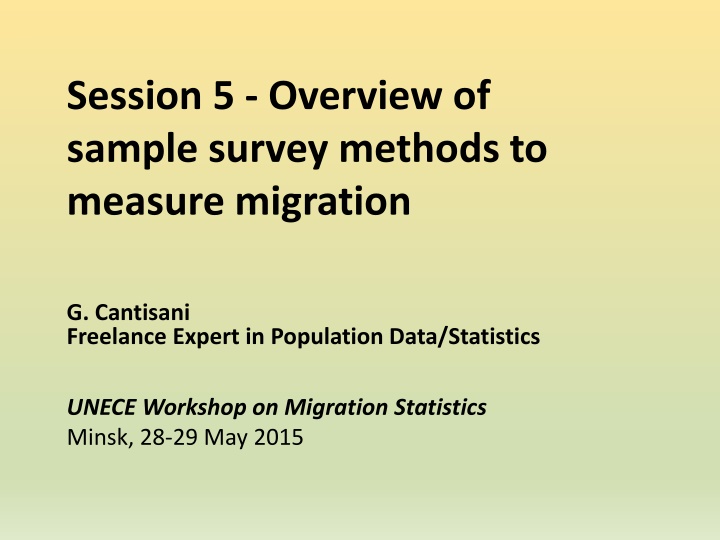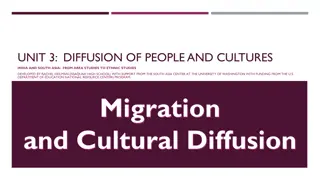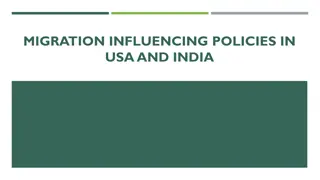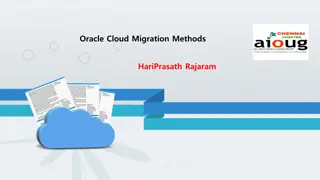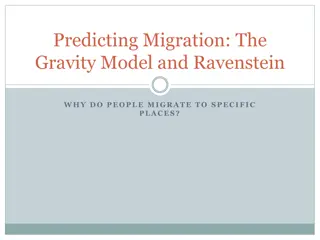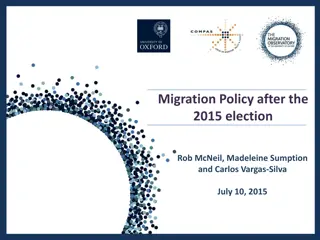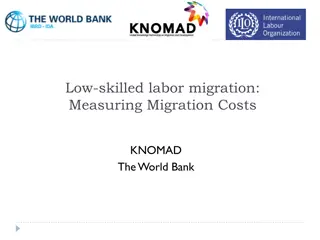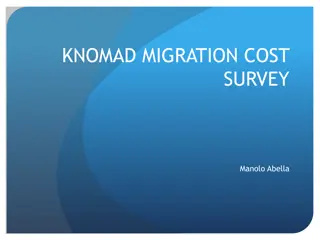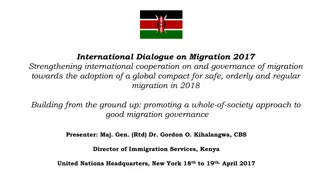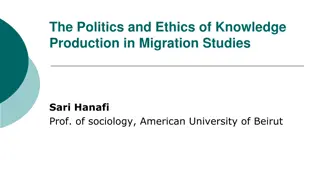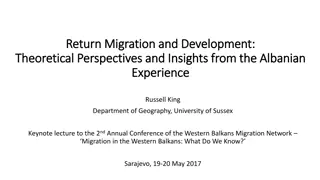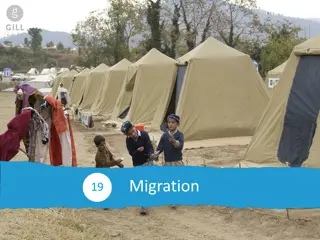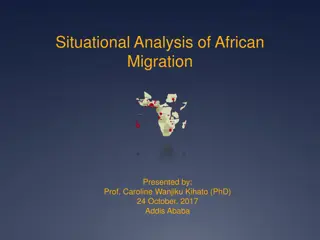Overview of Sample Survey Methods for Migration Studies
This presentation covers various sample survey methods to measure migration, including topics for migration studies, types of sample surveys, survey design, statistical sources of migration data collection, and recommendations for improvement in the CIS region. It outlines the different aspects of data collection and highlights the importance of choosing the most useful surveys for effective migration studies.
Download Presentation

Please find below an Image/Link to download the presentation.
The content on the website is provided AS IS for your information and personal use only. It may not be sold, licensed, or shared on other websites without obtaining consent from the author.If you encounter any issues during the download, it is possible that the publisher has removed the file from their server.
You are allowed to download the files provided on this website for personal or commercial use, subject to the condition that they are used lawfully. All files are the property of their respective owners.
The content on the website is provided AS IS for your information and personal use only. It may not be sold, licensed, or shared on other websites without obtaining consent from the author.
E N D
Presentation Transcript
Session 5 - Overview of sample survey methods to measure migration G. Cantisani Freelance Expert in Population Data/Statistics UNECE Workshop on Migration Statistics Minsk, 28-29 May 2015
Current proposal for Chapter III III.A - Sample survey overview 1. Topics for migration studies 2. Types of sample surveys 3. Choosing the most useful surveys III.B - Survey design and implementation 1. Definition of target population 2. Questionnaire design and contents 3. Sampling design 4. The whole survey process and other key phases III.C - Review of sample surveys and recommendations for improvement in the CIS Region 1. Review of sample surveys recently implemented 2. General Assessment 3. Proposals and recommendations for improvement 2
Contents of this presentation (as from Section III.A) Topics and statistical sources of migration data collection (basically representing III.A.1) Types of sample surveys (III.A.2) Border or passenger surveys General household surveys Household migration-specialized surveys ( household migration surveys hereinafter) Other migration-specialised surveys Choosing the most useful surveys (conclusions, III.A.3) Main references: ILO-1997, UNSD-1998, RB-2007, 3
Topics and statistical sources of migration data collection Successive needs/levels of measurement a. The number of migrants arriving to, living in or departing from a country. b. The main demographic and socio-economic characteristics of migrants. c. Other personal characteristics of migrants and the characteristics of their households and housing. d. The pre-migration situation and full biographies of migrants. e. The consequences (impact) and possible future features and trends of migration (e.g., the use of remittances, the personal attitudes and values, the migration intentions). f. Information on non-migrants. g. Longitudinal analysis (panel approach). h. The direct in-depth investigations on specific categories of migrants or waves of them due to episodic circumstances. 4
Topics and statistical sources of migration data collection A possible classification of statistical sources Population and housing censuses Border or passenger surveys Household surveys - Surveys on general social topics such as labour market - Surveys focusing on migration Other types of exhaustive or sample surveys based on counts, interviews and/or other methods (including direct or indirect data collection, mixed surveys, studies, ) 5
Topics and statistical sources of migration data collection Main aspects of data sources (1) 1. Periodicity/frequency 2. Applicability (e.g., border surveys in case of long land borders) 3. Coverage and data collection units (e.g., de jure vs. de facto population; internal/international migration; household/individuals; emigration of whole households) 4. Data collection tools, definitions and requirements (e.g., household roster & modules; usual residence; previous residence & threshold/cut-off period or date) 5. Sampling and generalisation of results (e.g., frame, design, size, catching of migrants or relevant households) 6. Approach of data collection (e.g., periodic vs. longitudinal surveys; proxy interviews) 6
Topics and statistical sources of migration data collection Main aspects of data sources (2) 6. Special investigations (e.g., determinants and impacts of migration; attitudes and intentions; use of remittances) 7. Statistical significance and reliability of results 8. Burden to respondents and acceptability (e.g., surveys undertaken outside the NSS) 9. Evolution of methods 10. Costs 7
Topics and statistical sources of migration data collection A broad classification of statistical sources in respect of the needs/levels of measurement Population census more for quantitative measurements on levels, patterns and trends of migration (as the administrative sources), in combination with a wide range of other information. Sample surveys more flexible and feasible, useful for more in- depth investigations and complementary qualitative information, in particular the determinants and consequences of migration mainly through specialised surveys. Both sources in principle needed for defining and implementing policy measures relevant for migration and development. 8
Border surveys Main features - Normally implemented to measure international migration, tourism and other topics. - Based on face-to-face interviews at (selected) border points. - Best suited to countries where border points are controlled and limited. - Also suitable to prepare other surveys. - Main constraints: Possibility to have a limited number of migrants in the sample leading to large sampling errors (e.g., 0.3% of passengers interviewed in the UK IPS catches about 1% of migrants only) Duration of movements based on intentions 9
Border surveys Components A module of screening questions on personal data such a the country of citizenship or residence and the reason of travel useful to identify passengers eligible for the interview. One or more modules of questions to be addressed to the respondents screened-in for surveying on international migration or other topics of investigation. A migration module may include further personal data such as marital status, educational attainment and economic status, information linked to the status or intention of migrants as well as information on the composition and residence of family members. 10
Border surveys Main initiatives -The International Passenger Surveys (IPSs) of United Kingdom and Cyprus. -Field-based exercises for estimating the flows of migrants in Libya episodically conducted in the main cities in the South of Country (around 2012). -A survey on migrant workers leaving from Pakistan to the Middle East implemented in three international airports (1979). -Surveys implemented at borders between Mexico and the US. 11
General household surveys Reference Surveys on labour market, income & expenditure, health, living conditions, other social topic or multi-purposes: LFS Labour Force Survey HBS Household Budget Survey DHS Demographic and Health Survey LSMS Living Standard Measurement Survey MICS Multiple Indicator Cluster Survey EU-SILC EU Survey on Income and Living Conditions 12
General household surveys Main features for measuring migration (1) Specific requirements and shrewdnesses for the selection of samples useful to cover the group of migrants or a number of them enough for the survey, in combination with the country migration profile: A large general sample, and/or A high incidence of the specific category of migrants subject to investigation. 13
General household surveys Main features for measuring migration (2) Specific requirements and shrewdnesses for the design of survey questionnaire: Household roster, with questions on in principle all household members (present, absent or even former members), and Specific modules on internal and/or international migration for selected household members or the household as whole (e.g., a module on work activity prior to immigration or in the destination countries vs. a module on remittances received by the household). 14
General household surveys Approaches for measuring migration i. One or more questions useful to identify migrants within the households Questions on country of birth, country of citizenship or place of previous. Questions allowing to determine the country of residence at a specific time in the past and the time(s) of arrival for permanent residence. ii. One or more separate modules on categories of population or aspects, normally in combination with one or more questions, depending on the migration profile of country, the purposes of investigation and the possibility to identify the different categories of data collection units and respondents. 15
General household surveys A possible questioning for identifying migrants Where were you born? Where were you living on (a specific past date)? [If in the same place/country] When did you arrive at your current residence? [If in another place/country] When did you (last) come to live in this place/country? 16
General household surveys Adoption of migration questions/modules - LFSs or employment/unemployment surveys: main case, frequent and often regular surveys, based on large samples, often already including some relevant questions and so adopted for measuring migration. - HBSs: also quite frequent surveys, ideal for knowing about the impact of migrant remittances on the households. - LSMSs: flexible surveys, with normally nationally representative but small samples, quite heavy questionnaires, so more rarely used. - DHSs: less frequent surveys, with nationally representative samples, less used for migration. - Other surveys: case by case. 17
General household surveys Main initiatives -The LFSs of Armenia, Moldova, Ukraine and other countries worldwide based on the ILO Labour Migration Module (since 2006). -Other general surveys of CIS countries, including panel surveys. -The LFSs of selected EU countries like Poland (in 2007, for immigration and emigration modules) and United Kingdom and all EU countries for the ad hoc modules (in 2008 and 2014). -The National Demographic Survey of Morocco (2009/10) as a panel survey. -The LSMSs and DHSs of countries like India, Philippines, Mexico, Costa Rica, Ecuador and Colombia (in 2005-2014). 18
Household migration surveys Main features Most suitable to inform about the migratory histories (the why, when and how of migration), the complete profiles, ways of life, attitudes as well as future the plans of individuals and households, i.e. the determinants, modalities, and consequences of migration. Flexible, may focus on specific components or aspects of migration such as the immigration of foreigners or selected groups of them into the country, the emigration of nationals abroad, the return migration or the intention of people towards emigrating abroad, separately or at same time. May apply to individuals as well as households as such. Generally also focus on control groups of individuals (e.g., non-migrants) and households (non-migrant households). 19
Household migration surveys A possible classification Immigration surveys Emigration surveys One-way surveys (i.e. surveys carried out in the countries of origin O or destination D) Both-way surveys (i.e., surveys carried out in countries O and D linked origin/destination country surveys ) Surveys on immigration and emigration Surveys on internal migration Surveys on specific topics (e.g., remittances) 20
Household migration surveys Main initiatives (in EU, CIS, MED & African countries) Recent migration surveys of Armenia, Tajikistan and Ukraine A proposal of survey programme in CIS countries (World Bank Project MiRPAL - Migration and Remittances Peer-Assisted Learning) REMUAO R seau d'Enqu tes sur les Migrations et Urbanisation en Afrique de l'Ouest EUROSTAT/NIDI Project Push & Pull Factors RDT Return Migration and Development Platform (under EUI, including CRIS and MIREM) Africa Migration and Remittances Project (the World Bank) Patterns of Migration and Human Resources Development (ETF) MAFE Migration between Africa and Europe MED-HIMS Household International Migration Surveys in MED countries TEMPER Temporary vs Permanent Migration Immigration surveys of Spain, France, Italy and Israel Longitudinal surveys on immigration in Canada, US, Australia and NZ 21
Household migration surveys The proposal for studying international migration and remittances in the CIS countries Proposed in 2012 under the World Bank Project MiRPAL (in RB-2012) following an assessment (in RB-2011). Programme of both-way surveys similar to the EUROSTAT/NIDI Project playing on the migration system represented by CIS countries. Adopting the same study population (i.e. out-migrants, return migrants and non-migrants) and similar definitions and methodologies in the two types of countries. Based on changes of permanent residence involving a change of country occurred within the past 10 years. Sampling based on the stratification with disproportionate probabilities of selection of area units and then a two-phase selection of households. 22
Other migration surveys Main features (1) Residual category, including a varying range of targeted operations and data collection strategies. Main features (eventually alternative): The implementation in places different from border points or households (e.g., workplaces, public places, refugees camps) The data collection from respondents and/or informants different from migrants The use of methods different from interviews or the combination of them (e.g., surveys based on self-compilation of questionnaires or a study based on interviews of individuals, in-depth interviews with experts and focus group discussions) 23
Other migration surveys Main features (2) Surveys on specific categories of migrants or descendants of migrants, such as: Usual groups like migrant workers or international students Second generations Irregular migrants People living in collective households Migrants receiving a form of protection or assistance People who massively concentrate in urban suburbs Members of diasporas communities abroad Surveys on several aspects of migration such as Remittances sent by hometown associations to organisations and communities in their home country Social remittances of migrant workers 24
Other migration surveys Main features (3) Opportunities but also risks from the limited availability of methodological references and the variety, flexibility and subjectiveness of methods. Recommendations for moving on carefully, adopting precautionary measures, exchanging opinions and learn from existing surveys under the international coordination. 25
Other migration surveys Main initiatives - The mapping of Moldovan diaspora in selected EU countries prepared on behalf IOM (2012). - Several rounds of surveys on irregular migration in Italy adopting the Center Sampling Technique (since nineties). - An exercise for estimating the size of illegally resident population in the four largest Dutch cities (1998). - A study on mixed migration in Libya prepared on behalf of UNCHR (2013). - The profiling and assessment exercises on IDPs, urban migrants or other categories of migrants carried out the Joint IDP Profiling Service (JIPS) using a variety or integration of data collection methods and sampling strategies (since around 2010). - The Mexican Migration Project gathering data on regular and irregular Mexican migrants to the US (since 1982). 26
Conclusions Main conditions for using/setting sample surveys Migration profile of country Needs of information Degree of understanding of the usefulness of evidence-based policy-making by the governmental services Existing availability of operations and data/statistics Distinction between quantitative and qualitative measurements Inter-institutional collaboration Technical capabilities and financial resources 27
Conclusions Example A country with a unchanging migration profile, with significant permanent inflows of labour migrants since decades, with good levels of integration and irrelevant outflows. Integrated system based on statistics based on administrative sources (available on yearly/quarterly frequency), population census (every ten year) and a household specialised survey (less frequently). A main general household survey for monitoring the yearly migration flows and more in-depth investigation on specific topics covered through rolling modules. .. 28
Conclusions Main opportunities To choose the surveys and their specific modalities within a comprehensive systems aiming to answer the different needs. To build systems suitable for possible even fast adaptation and consider the development of data registration, the introduction of methodologies and means more tailored to the specific cases (e.g., Internet and mobile communication) as well as the synergies between operations, institutions and countries (e.g., both-way surveys). 29
Thank you for your attention 30
